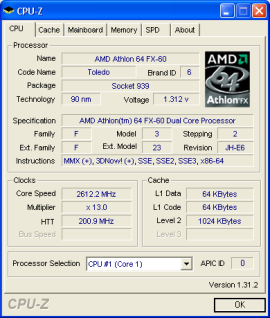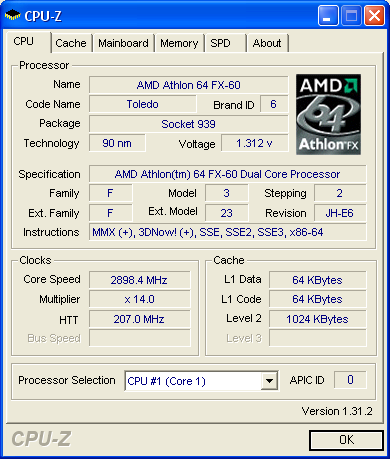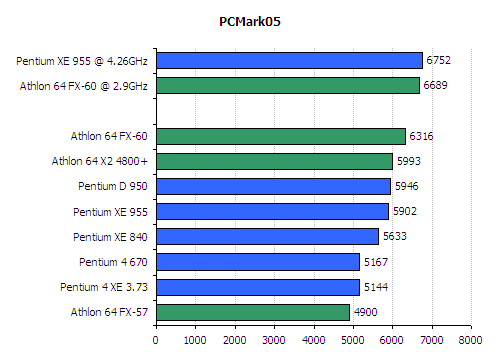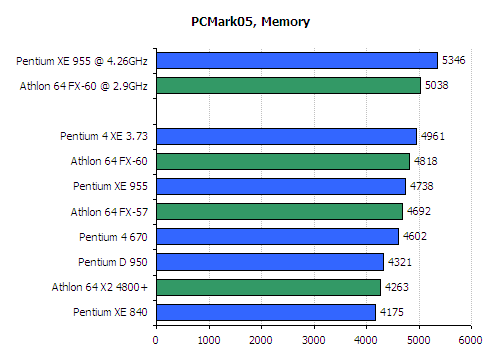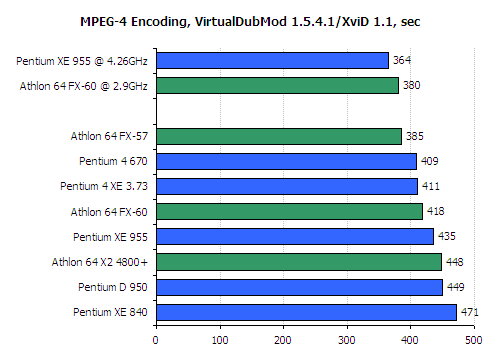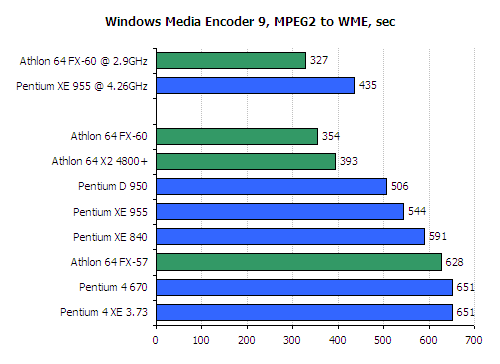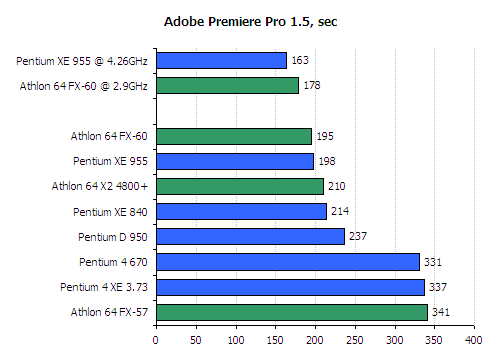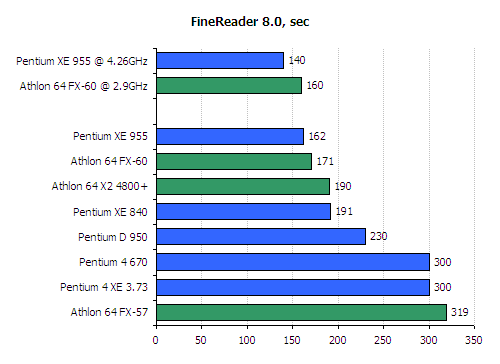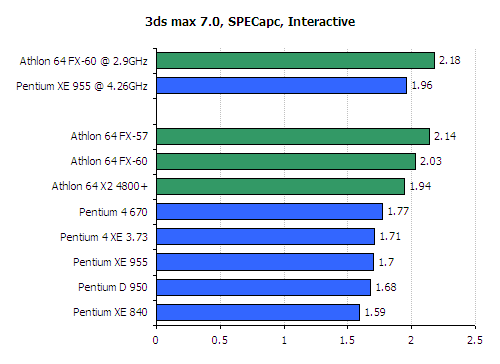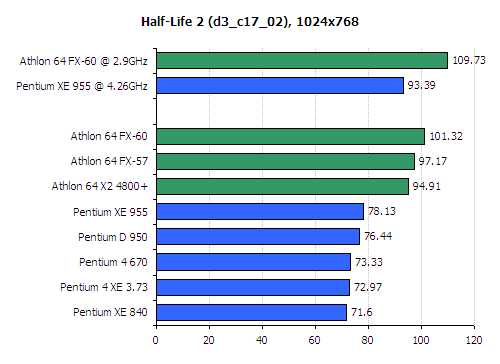FX 60 CPU REVIEW - AMD ATHLON 64 FX 60 REVIEW
![]()
|
|
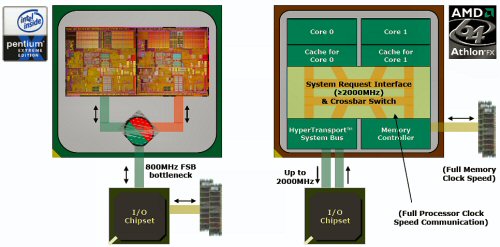 |
||||||||||||||||||||||||||||||||||||||||||||||||
| Posted:2006-04-05 By The Game Number of View:11497 |
|||||||||||||||||||||||||||||||||||||||||||||||||
By :The Game Posted:2006-04-05
FX 60 CPU Review - AMD Athlon 64 FX 60 ReviewFollowing in Intel’s footsteps, AMD transfers its CPUs for extreme gamers, the Athlon 64 FX, to dual-core architecture. The new processor we will look at today is based on the new Toledo core overclocked to 2.6GHz. Will this innovation be enough to respond to Intel’s Pentium Extreme Edition 955? Let’s find out now The dual-core newcomer from AMD works at 2.6GHz core clock rate, which is the same as the working frequency of the single-core Athlon 64 FX-55, which has been the most attractive processor for the gamers and enthusiasts throughout the entire 2005. In the new year, when the new Athlon 64 FX-60 takes over the stage, its predecessor will have to leave for good. So, the top price range in the AMD CPU line-up will be formed by the single-core Athlon 64 FX-57 working at 2.8GHz and a dual-core Athlon 64 FX-60 working at 2.6GHz. The clock frequency of both these processors is higher than that of any other Athlon 64 and Athlon 64 X2 CPUs. So, the performance of the new Athlon 64 FX-60 will anyway be higher than that of any other AMD processors, maybe with only one exception of Athlon 64 FX-57. However, our primary goal today is to compare the performance of the competing processor solutions against one another. Therefore, in this article we will compare the new Athlon 64 FX-60 CPU not that much against the single-core AMD processors, but mostly against the dual-core Intel processors based on the new Presler core. I would also like to stress that top-end Presler based CPUs have proven pretty successful, as they had no direct competitors for quite some time. Higher clock frequency and larger L2 cache of Intel’s dual-core processors as well as their transition to finer production process guaranteed increased performance on the one hand, and higher overclocking potential on the other. Being the direct competitor to Intel’s top CPU on the Presler core – Intel Extreme Edition 955, Athlon 64 FX-60 has only higher working frequency than that of the Athlon 64 4800+ to offer. Will it be enough for the newcomer to defeat Intel’s competitors in the majority of applications? This is the main question we are going to answer today in our new review. Athlon 64 FX-60: Closer Look( FX 60 CPU Review -AMD Athlon 64 FX 60 Review )Although Athlon 64 FX-60 is the first dual-core CPU in the Athlon 64 FX processor family, there are not so many innovations that this processor has acquired. Just as the top dual-core processor from the Athlon 64 X2 family, the 4800+ model, the newcomer is based on Toledo core. In other words, Athlon 64 FX-60 features two cores, each with 1MB L2 cache. It is manufactured with 90nm production technology. The only difference between the Athlon 64 FX-60 and the Athlon 64 X2 4800+ is the higher clock frequency of the former, that has now been increased by 200MHz and equals 2.6GHz. The formal specs of the new AMD processor are given in the table below:
As we see, the increase in the Toledo core clock speed hasn’t affected the typical heat dissipation value claimed by the manufacturer. In other words, Athlon 64 FX-60 is fully compatible with all the mainboards and cooling systems, which work fine with Athlon 64 X2 4800+ CPUs. It seems to have been far not an easy job for AMD to make all the thermal and electrical characteristics of the new solutions fit into the previous boundaries. The lower nominal Vcore of the new Athlon 64 FX-60 is an evident indicator of this fact. While the top Athlon 64 FX and Athlon 64 X2 processors work at the nominal voltages lying between 1.35V-1.4V, the Vcore of the new Athlon 64 FX-60 has been dropped down by 0.05V. This seems to be one of the major tricks AMD used to ensure the compatibility of the newcomer with the existing platforms. As a result, the manufacturer has to pay more attention to speed binning of the semiconductor dies that will become the basis for the new Athlon 64 FX-60. However, this will hardly affect the availability of the new CPUs. On the one hand, AMD claims that the processors will be available at launch already, but on the other, we wouldn’t expect any superior demand for the CPUs worth $1,031 a piece. The new version of the CPU-Z utility recognizes all the features of Athlon 64 FX-60 correctly:
I would like to stress that the previous versions of this utility that were not familiar with the Athlon 64 FX-60, did see a system like that as a dual-processor system built with a pair of regular Athlon 64 CPUs. Power Consumption( FX 60 CPU Review -AMD Athlon 64 FX 60 Review )Well, AMD did everything necessary to keep the power consumption and heat dissipation of the new Athlon 64 FX-60 within the same boundaries as the corresponding parameters of the top dual-core CPUs from the Athlon 64 X2 family. This requirement is determined primarily by the contemporary mainboards, which voltage regulator is not designed to support higher electrical power. By the way, the upcoming AMD platform that should be launched in Q2 2006, Socket M2, will support CPUs with the typical heat dissipation of up to 125W. It means that in the near future AMD will be able to continue raising the working frequencies of its CPUs without shifting to the new manufacturing process. And in the meanwhile, they managed to reach the 2.6GHz frequency for Toledo core by lowering the processor Vcore. However, this is all pure theory. How did the power consumption of the new Athlon 64 FX-60 processor change compared with that of the predecessor, Athlon 64 X2 4800+? To answer this question we carried out a short test session where top AMD and Intel processors took part. The diagram displays the maximum CPU power consumption achieved during our practical tests. As usual, the CPUs were loaded to their maximum with the help of S&M utility. As for the measurement techniques, we measured the current that goes through the CPU power circuitry on the mainboard. So, the numbers given below do not take into account the efficiency of the CPU voltage regulator laid out on the mainboard.
According to the obtained results, a few small losses couldn’t help AMD here. Despite all the tricks, Athlon 64 FX-60 consumes more power than the Athlon 64 X2 4800+. Although, the electrical and thermal parameters of the new Athlon 64 FX-60 do not exceed any critical values. Moreover, this CPU is much more economical than the competitor’s solution based on the new 65nm Presler core. Thus, the power consumption of the Pentium Extreme Edition 955 exceeds the power consumption of Athlon 64 FX-60 by well over 40% with all the resulting consequences. So, K8 architecture has once again proven its superiority over Intel’s NetBurst. Here I would like to stress that dual-core AMD processors consume much more power than their single-core fellows. This can be explained by the relatively small difference in their working frequencies. As for Intel, they do their best to level out the power consumption of their single-core and dual-core solution by significantly reducing the clock speed of the latter ones. As for the thermal and electrical characteristics of the new Athlon 64 FX-60 in idle mode, I would like to stress here that this processor supports Cool’n’Quiet technology. In idle mode this processor can slow down to 1.2GHz clock speed and drop the Vcore to 1.1V. In this case the power consumption reduces to 8.5W, which turns Athlon 64 FX-60 into a very economical CPU. However, they could have achieved even better effect if the two cores of the Athlon 64 FX-60 processor could switch to power saving mode independently. However, this feature is most likely to be implemented only in those dual-core AMD processors that will be targeted for the mobile market segment. Overclocking( FX 60 CPU Review -AMD Athlon 64 FX 60 Review )Here I would like to once again refer to the article we posted two weeks ago that was called First Look at Presler: Intel Pentium Extreme Edition 965 CPU Review , where we gave due credit to the new Intel processor for its great overclocking potential. The semiconductor die manufactured with 65nm production process allowed us to easily increase the CPU core clock up to 4.26GHz, i.e. by 25% above the nominal. I have to say that the performance of the dual-core Presler processor working at this frequency appeared pretty impressive. However, if you have read our previous review, you should remember, that there was no opposition to the overclocked Pentium Extreme Edition 955, namely we didn’t mention the results of the overclocked dual-core AMD processors. This was actually one of the reasons why our article has been severely criticized by many readers. Today we are going to make up for this disappointing omission. We got an excellent processor for our overclocking tests: Athlon 64 FX-60. Even though it cannot boast the new finer manufacturing technology, which could help increase the frequency potential of the solution, the newcomer still boasts a few innovations that can be very helpful for successful overclocking experiments. Here we first of all mean the lower Vcore, as well as more thorough selection of the Toledo processor cores for Athlon 64 FX-60 CPUs. Just as during the Pentium Extreme Edition 955 tests, we were primarily interested in the results we could achieve on our Athlon 64 FX-60 without involving any additional super-cooling systems. Therefore our test platform was built with DFI NF4 Ultra-D mainboard on NVIDIA nForce4 Ultra chipset and a pretty simple AVC Z7U7414001 air cooler. We used a pair of Corsair CMX1024-3500LLPRO memory modules for the RAM subsystem. Besides, there was also an NVIDIA GeForce 7800 GT graphics card and Western Digital WD740GD hard disk drive. I would like to point out that Athlon 64 FX-60 processor is very easy to overclock, unlike its Athlon 64 X2 counterparts. Its clock frequency multiplier is unlocked, just like in all other Athlon 64 FX CPUs. It means that we can overclock it not only by raising the bus frequency, but also by increasing the multiplier. We paid special attention to this feature during our overclocking experiments. We managed to get our CPU to work stably with the clock frequency multiplier set to 14x without increasing the Vcore, which equaled 1.3V throughout the entire test. In other words, our processor worked just fine at 2.8GHz clock speed. Unfortunately, Athlon 64 FX-60 didn’t get along with the 15x clock multiplier. Having increased the Vcore by 10% above the nominal, we still couldn’t get our hero to run stably at 3GHz frequency. Although the CPU would boot the Windows XP just fine and could even go through some test applications, it would still crash to the Blue Screen of Death (BSOD) when both cores were fully loaded. So, we had to give up or desperate intention to conquer the 3GHz height. We managed to get our processor to work absolutely impeccably at 2.9GHz with the Vcore set to 1.44V. This frequency was achieved as 14 x 207MHz.
The CPU temperature under 100% workload equaled 69-70o C. In the nominal mode the core temperature of our Athlon 64 FX-60 didn’t rise over 53o C. It indicates that you shouldn’t forget about efficient cooling when you overclock your dual-core AMD Athlon 64 FX-60. Testbed and Methods( FX 60 CPU Review -AMD Athlon 64 FX 60 Review )During this test session we will compare the performance of our today’s hero, dual-core AMD Athlon 64 FX-60 processor, against the performance of the top processors with single-core and dual-core architecture from AMD and Intel. In other words, among the rivals will be the candidates from the following processor families: Athlon 64 FX, Athlon 64 X2, Pentium 4, Pentium 4 Extreme Edition, Pentium D and Pentium Extreme Edition. During our test session we assembled a few testbeds with the following components:
The BIOS Setup of the mainboards was adjusted for maximum performance Performance( FX 60 CPU Review -AMD Athlon 64 FX 60 Review )SYSMark 2004 SEAs usual, we will test the performance of our systems in “general-purpose” applications with the SYSMark 2004 SE testing suite. This benchmark emulates the user’s work in popular applications with multi-tasking of the operating system actively involved
The applications intended for creation and processing of digital content are very well-optimized for multi-processor environments. Therefore, the performance of our dual-core processors appears higher than that of the single-core ones. At the same time, the dual-core AMD processors easily outperform Intel Pentium Extreme Edition and Intel Pentium D.
The performance in office application doesn’t get that much faster due to the second core. Nevertheless, the dual-core newcomer, Athlon 64 FX-60, wins the first prize in this test. It is evidently explained by the small frequency difference between the dual- and single-core AMD processors. If we take a look at the performance of the Intel processors, we will notice that the dual-core CPUs fall behind their single-core counterparts. It is true, while the performance difference between the Athlon 64 FX-60 and Athlon 64 FX-57 is only 7.5%, the clock frequencies of the Pentium Extreme Edition 955 and Pentium 4 670 differ by 10%. Moreover, the slightly better design of the AMD’s dual-core architecture also plays an important role here. Toledo (and Manchester) CPUs, unlike Presler and Smithfield, do not use a system bus to arrange communication between the cores, i.e. they use up the platform resources in a more efficient way.
PCMark05( FX 60 CPU Review -AMD Athlon 64 FX 60 Review )PCMark05 is another popular test suite for “general” system performance. Since it creates multi-threaded workload during work, the CPUs with two cores perform the best of all in it.
According to PCMark04, dual-core AMD processors perform the best here and leave behind Intel’s dual- and single-core CPUs. At the same time, I would like to point out that this conclusion is not valid for the performances of the overclocked Athlon 64 FX-60 and Pentium Extreme Edition 955. When we overclock these CPUs, the picture changes: Presler working at 4.26GHz shows better results than the 2.9GHz Toledo. However, there is nothing to be surprised with. We managed to overclock Pentium Extreme Edition 955 by 23% above the nominal, while the frequency of the AMD processor could increase by only 11.5% because of the older 90nm production technology.
The CPU subtest of the PCMark05 test is optimized for NetBurst architecture that is why Intel processors perform better there. As for the memory subsystem performance, we shouldn’t expect any significant improvement from AMD here, until the company launches their Socket M2 platform supporting the new prospective DDR2 SDRAM. Audio and Video Encoding( FX 60 CPU Review -AMD Athlon 64 FX 60 Review )
When both leading CPU makers introduced their dual-core solutions the overall picture in the applications dealing with the media content encoding has become slightly different. This is what we see in the benchmark above: dual-core processors from AMD cope better with MP3 files encoding than their rivals from Intel.
Athlon 64 FX-60 also outperforms Pentium Extreme Edition 955 in the new version of the DivX codec featuring quality multi-threading optimization. However, the advantage is pretty small in this case. So, when we overclock both CPUs, the laurels go to the new leader.
XviD codec doesn’t support multi-threading yet. Therefore, when we use this particular codec, the dual-core CPUs use only 50% of their potential.
However, the Windows Media Encoder that creates two computational threads during work allows dual-core processors to really show their best. The leadership here belongs to AMD (Toledo), which remain unattainable for Pentium Extreme Edition 955 even when it is overclocked to 4.26GHz. Image and Video Editing( FX 60 CPU Review -AMD Athlon 64 FX 60 Review )
The situation in two major image and video editing applications for professionals is very similar to what we have just seen. The new AMD Athlon 64 FX-60 processor outperforms the Intel competitor, but after we overclock both guys, the situation changes to completely the opposite. We have also included a popular application for optical text recognition called ABBYY FineReader 8.0. This application is pretty well optimized for multi-threading, which you can clearly see from the diagram below
First of all, I would like to point out that the performance in FineReader improves significantly in systems with Hyper-Threading. This partially explains the success of Pentium Extreme Edition 955: this CPU outperforms Athlon 64 FX-60 in the nominal mode as well as in overclocked mode. 3D Modeling and Rendering( FX 60 CPU Review -AMD Athlon 64 FX 60 Review )
Although the final rendering in 3ds max can be easily split into a few parallel threads, we cannot say the same about the work in viewports. So, we see two completely different results in one and the same application. Dual-core processors are leading the race during final rendering, while in viewports the result is just the opposite. Of course, we are first of all interested in the final rendering speed, as it is the most resource hungry process here. Our today’s hero, Athlon 64 FX-60, proved pretty successful. The newcomer from Intel, the Pentium Extreme Edition 955, which we called the fastest CPU for rendering tasks only two weeks ago, has now been defeated by the AMD Athlon 64 FX-60. However, when we overclock the Intel processor, it wins back the leadership: the 65nm Presler core features very significant frequency potential, which can be put to good use if we disregard the high heat dissipation and power consumption threats emerging during overclocking. I have to stress that we can observe similar picture in other applications of the kind, such as Maya, for instance.
Gaming Applications( FX 60 CPU Review -AMD Athlon 64 FX 60 Review )In our article called First Look at Presler: Intel Pentium Extreme Edition 965 CPU Review we described all the issues connected with the performance of the dual-core processors in games in great detail. The thing is that even though the current version of NVIDIA drivers does support multi-threading formally, in reality this support is not quite polished-off yet. In other words, we do not doubt the presence of multi-threading support in the current version of NVIDIA’s ForceWare drivers, but for some reason it is activated not every time when it could really improve the performance. As a result, we see pretty strange fluctuations in the obtained results. This is actually the reason why in the previous review we didn’t enable the multi-threading support in the drivers at all. NVIDIA gave us a new driver version 81.97 for this new round of benchmarks. According to the driver developers, all the above listed problems have been successfully eliminated in this driver version. I have to admit that this is mostly true. In most cases we noticed a performance improvement in systems built with dual-core processors. However, not all the problems have been eliminated. For example, you will have to disable the multi-threading support in the drivers for AMD Toledo based systems if the games support multi-threading already. Otherwise, you will not be able to achieve the maximum performance. Moreover, Pentium Extreme Edition processors featuring four computational virtual cores puzzle the drivers completely, so that we have to disable the Hyper-Threading technology in these CPUs, in order to achieve more or less correct results. Therefore, since the situation with the drivers hasn’t been completely resolved yet, and the drivers haven’t been optimized for dual-core processors, the benchmark results should still be regarded as preliminary.
According to the diagrams above, a lot of gaming applications, even not the most contemporary ones, can actually benefit significantly from the use of dual-core processors by simply installing the optimized drivers. For instance, you can see the effect from these drivers in Half-Life 2 and FarCry with a naked eye. Contemporary dual-core processors outperform the top-of-the-line single-core CPUs in these games. However, in some latest gaming titles, such as F.E.A.R., the dual-core architecture provides almost no evident advantage. As for the performance correlation between the Intel; and AMD CPUs, the release of the optimized drivers doesn’t change anything. AMD processors remain faster in games. And even overclocking doesn’t help Intel to win back the leadership. Conclusion( FX 60 CPU Review -AMD Athlon 64 FX 60 Review )First of all I would like to point out that the year 2006 promises to become the year of overwhelming spreading of dual-core processors. Thanks to the efforts of the graphics card driver developers, the number of applications improving showing better results with the multi-threading enabled keeps growing constantly. And the most important thing is that among these apps are the games, performance in which is essential for many users out there. This was one of the primary reasons why AMD transferred the extreme gaming processors, Athlon 64 FX, to the more advanced dual-core architecture. The new AMD Athlon 64 FX-60 we reviewed today appeared the first dual-core processor in this family. By launching their new dual-core Athlon 64 FX-60 processor, AMD responded worthily to Intel’s Pentium Extreme Edition 955. There were quite a few cases when the new Intel CPU could probably shaken AMD’s leadership, however, the just launched AMD Athlon 64 FX-60 doesn’t leave the competitor even a single chance in almost all of them. Among the indisputable advantages of the newcomer from AMD targeted for the high-end pricing segment of the market I should list lower power consumption and heat dissipation than that of the competitor’s solutions. In other words, despite the recently announced 65nm Presler core from Intel, the overall situation in the market remains unchanged. CPUs with NetBurst architecture cannot be regarded as a successful alternative to contemporary AMD solutions. So, at least until H2 2006, when Intel is going to release a principally new Conroe processor, AMD will remain the leader by providing the fastest and most economical CPUs for the top-end market segment. However, we shouldn’t say that Presler got completely and hopelessly defeated by the new Athlon 64 FX-60. Due to the new finer production technology, the new dual-core processors from Intel can boast excellent overclocking potential. As for the frequency potential of the AMD processors, it has been almost completely exhausted by now. As a result, when we compare the results demonstrated by the overclocked AMD Athlon 64 FX-60 and Intel Pentium Extreme Edition 955, the former is not always the winner. So, if you do not mind your system being a little bit noisy and generating quite a bit of heat, then Pentium Extreme Edition 955 might be a way to go. And in conclusion I would like to say that the launch of Athlon 64 FX-60 doesn’t really affect the situation in the mainstream AMD processor line-up. Unfortunately, the youngest dual-core CPUs from AMD cost much more than the competitor’s solutions, which have also migrated to a faster and more economical Presler core. Therefore, if the situation in the high-end market segment is pretty clear, then in the mainstream things might change quite dramatically later on.
we would be happy to answer for your question . if you have suggestion or comment
regarding this review our support would be glad to help just join our forum and ask u will get the best answer
to discuss check our forum section :-) RATE THIS REVIEW | |||||||||||||||||||||||||||||||||||||||||||||||||
![]()

7600gt review
7600gt is the middle card range.
We already benchmarked this video card and found that ...

 geforce 8800gtx and 8800gts
geforce 8800gtx and 8800gts  Xtreview software download Section
Xtreview software download Section  AMD TURION 64 X2 REVIEW
AMD TURION 64 X2 REVIEW  INTEL PENTIUM D 920 , INTEL PENTIUM D 930
INTEL PENTIUM D 920 , INTEL PENTIUM D 930  6800XT REVIEW
6800XT REVIEW  computer hardware REVIEW
computer hardware REVIEW  INTEL CONROE CORE DUO 2 REVIEW VS AMD AM2
INTEL CONROE CORE DUO 2 REVIEW VS AMD AM2  INTEL PENTIUM D 805 INTEL D805
INTEL PENTIUM D 805 INTEL D805  Free desktop wallpaper
Free desktop wallpaper  online fighting game
online fighting game  Xtreview price comparison center
Xtreview price comparison center 

- The new version of GPU-Z finally kills the belief in the miracle of Vega transformation
- The motherboard manufacturer confirms the characteristics of the processors Coffee Lake
- We are looking for copper coolers on NVIDIA Volta computing accelerators
- Unofficially about Intels plans to release 300-series chipset
- The Japanese representation of AMD offered monetary compensation to the first buyers of Ryzen Threadripper
- This year will not be released more than 45 million motherboards
- TSMC denies the presentation of charges from the antimonopoly authorities
- Radeon RX Vega 64 at frequencies 1802-1000 MHz updated the record GPUPI 1B
- AMD itself would like to believe that mobile processors Ryzen have already been released
- AMD Vega 20 will find application in accelerating computations
- Pre-orders for new iPhone start next week
- Radeon RX Vega 57, 58 and 59: the wonders of transformation
- ASML starts commercial delivery of EUV-scanners
- The older Skylake processors with a free multiplier are removed from production
- Meizu will release Android-smartphone based on Helio P40
- AMD Bristol Ridge processors are also available in American retail
- The fate of Toshiba Memory can be solved to the next environment
- duo GeForce GTX 1080 Ti in GPUPI 1B at frequencies of 2480-10320 MHz
- New Kentsfield overclocking record up to 5204 MHz
- Lenovo released Android-smartphone K8



computer news computer parts review Old Forum Downloads New Forum Login Join Articles terms Hardware blog Sitemap Get Freebies

